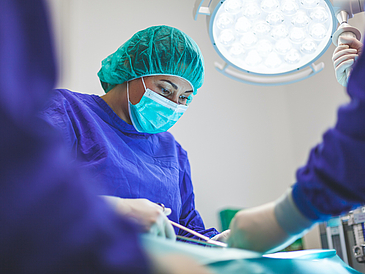Increasing safety in operating theaters forms the heart of the new Smart-OT research project. The main aim of the consortium that comprises the field of science and medical technology companies is to develop an intelligent surgery lighting system that ensures precise lighting without requiring manual controlling. The advantages: Surgeons have their hands free and have good sight even when people are moving in the room. The workload of those working on the surgery team is reduced in this way and at the same time, the safety of patients is increased.
Important Step Towards Being a Part of Daily Operating Practices
Intelligent operating theater lighting is made possible by the application of innovative light and controlling concepts that are interactively connected to each other and are to be transferable to other operating theater equipment. Smart-OT expands on the Intra-operative Information project, which was carried out by the University of Bremen in the frame of the Excellence Initiative together with regional hospitals and which revealed specific opportunities for improvement in operating theaters. An important step for practical application is being taken with Smart-OP.
The majority of hardware development in the project will be carried out by the Dr. Mach and Qioptiq companies. The Computer Graphics & Virtual Reality Working Group at the Center for Computing Technologies (TZI), University of Bremen, is providing software for the autonomous controlling of the lighting. “One of the challenges in optimally ordering and coordinating numerous small lights that are to be implemented instead of the usual large lamps,” says Professor Gabriel Zachmann, head of the working group at TZI.
In order to enable surgeons to readjust the lighting with only slight effort if required, the Digital Media Lab Working Group, led by Professor Malaka at TZI, is expanding the system with gesture and voice controls.
The University of Oldenburg and the Pius Hospital (Professor Dirk Wehye) are assessing the practical applicability of the system together with the KIZMO – this spans from the requirements analysis, to the usability, to evaluation from demonstrators. In a laboratory developed especially for research questions (Living Lab), simulated surgeries can be carried out with the developed technologies and the working steps can be tested.
Project Directed by Worldwide Leading Manufacturer of Medical Lighting Systems
The leadership of the project is held by the Dr. Mach GmbH & Co. KG company. The company is one of the worldwide leading manufacturers of medical lighting systems. The Pius Hospital Oldenburg – clinical partner of the University of Oldenburg – and the company Qioptiq Photonics and the Klinische Innovationszentrum für Medizintechnik Oldenburg (Clinical Innovation Center for Medical Technology Oldenburg) – KIZMO are also involved. The University of Bremen is represented by the Center for Computer Technologies (TZI). The project, which is to be completed at the end of 2021, is receiving funding of 1.2 million euros from the Federal Ministry of Education and Research (BMBF).
Further Information:
Contact:
Axel Kölling
Public Relations
Center for Computing Technologies (TZI)
University of Bremen
Phone: +49 (0)171-5305119
Email: axel.koellingprotect me ?!uni-bremenprotect me ?!.de
Dr. Peter Kohrs
Dr. Mach GmbH & Co. KG
Flossmannstrasse 28
85560 Ebersberg
Germany
Email: infoprotect me ?!smart-otprotect me ?!.de

